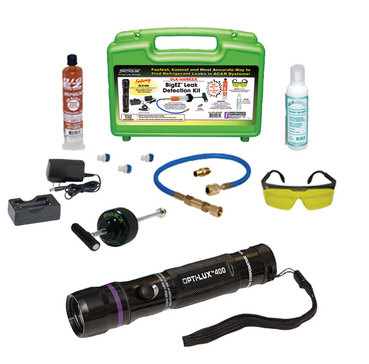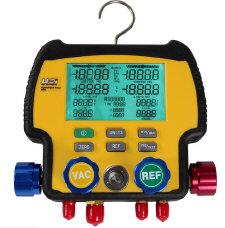
Auto Repair Library, Auto Parts, Accessories, Tools, Manuals & Books, Car BLOG, Links, Index



If you want to service the air conditioning system on your vehicle, here are some A/C service tools you may need:
Gauge sets One for R-12 A/C systems if you have a 1994 or older vehicle, one for 1996 to 2015 R-134a A/C systems, and/or a third gauge set for 2015 and newer vehicles if it has a R-1234yf A/C systems. Separate gauge sets are necessary because the hose connections are different, and you also want to avoid cross-contamination of refrigerants if you are working on different types of systems.
A gauge set is used to read the high and low side pressures in an A/C system. These readings can provide essential diagnostic information for troubleshooting cooling problems. The gauge set is also used when recharging the system with refrigerant.
Minimum requirements: The low pressure gauge should be capable of reading from zero to 30 inches of vacuum Hg, and zero to 250 psi. The high pressure gauge should have a range of zero to 500 psi.
Refrigerant recovery equipment. This is only required for professional repair shops, not do-it-yourselfers. Even so, until recently it was illegal under EPA rules for anyone to vent ANY type of refrigerant (R-12, R-134a and R-1234yf) into the atmosphere during service procedures. Federal clean air regulations have required recovery and recycling of all refrigerants from a vehicle's A/C system prior to performing any type of service work that involves opening up the system. But these rules recently changed:
As of March 2020, the EPA published a new rule revising its previous rules that prohibited the venting of all refrigerants into the air when servicing a vehicle, whether or not they contain CFCs or global warming gases. R-12 still shout NOT be vented and should be recovered, but now apparently it is okay to vent R-134a and R1234yf during servicing procedures. No recovery is required.
The new rule also eliminates previous regulatory requirements regarding leak inspection and repair for R-134a and R-1234yf because both do not contain ozone depleting CFC chemicals.
Refrigerant recovery and recycling equipment must meet Society of Automotive Engineers (SAE) standards. In addition, different types of refrigerant must not be intermixed. This requires a separate recovery/recycling machine for each type of refrigerant used: one for R-12, one for R-134a (or a combination machine that includes separate circuits and storage tanks for R-12, R-134a and also R-1234yf, plus one additional recovery machine for any other "alternative" refrigerants that may be used (this includes blended refrigerants as well as RVs & trailers using R-22).
The updated (March 2020) EPA rules will also require A/C recover equipment for R-1234yf A/C systems to meet updated SEA standards:
J2843_201301 Recovery/recycling/Recharging Equipment for R-1234yf Refrigerants for Mobile Air-Conditioning Systems.
J2851 Recovery Equipment for Contaminated R-134a or R-1234yf Refrigerant from Mobile Air Conditioning Systems
J3030 Automotive refrigerant Recovery/Recycling/Recharging Equipment Intended for use with Both R-1234yf and R-134a.
Professional technicians (not DIYers) who do A/C work must also be "certified" as having successfully passed an EPA-approved training course on recycling and recovery procedures. This is NOT a requirement if you do your own repairs.
Thermometer for measuring air temperature at the A/C outlets to diagnose cooling performance. A thermometer should be capable of measuring air temperature from 20 degrees up to 100 degrees Fahrenheit. A non-contact infrared thermometer is also a useful tool for measuring the surface temperature of A/C hoses, the condenser and radiator.

Leak detector or leak detection dye to find refrigerant leaks. It is pointless to recharge an A/C system if it has a leak. It may work for awhile, but sooner or later the refrigerant will leak out again. The least expensive and easiest way to find leaks in your A/C system is to add dye to the system. After several days it will leak out and leave telltale stains where the system is leaking. Many dyes are fluorescent and will glow bright green or yellow when illuminated with an UV light. Electronic leaks detectors typically cost several hundred dollars and are too expensive for most do-it-yourselfers. But electronic leak detectors are good for finding leaks in hidden areas that are difficult or impossible to see directly (such as an evaporator leak inside the HVAC unit). Sensitivity depends on the model, but most can detect leaks as small as 0.1 to 0.4 ounces per year.
Vacuum pump for purging air and moisture from the A/C system prior to recharging it with refrigerant. The pump should be capable of pulling a minimum of 29.5 inches of vacuum Hg. (This is included in almost all recovery and recharging stations.) The A/C system also has to be purged if you open any hoses to replace any parts. Air and moisture get inside. Air displaced refrigerant and can reduce cooling efficiency, while moisture can form acids and sludge that can damage the compressor and other metal parts.

Refrigerant identifier is an expensive tool that many repair shops use to identify and verify the type of refrigerant in a vehicle's A/C system before they service it. This reduces the risk of cross-contaminating their A/C recovery/recycling equipment. The more sophisticated equipment will even reveal the exact percentages of various refrigerants and contaminants in the system. But these are expensive tools, costing over $1500 or more. So if you suspect bad refrigerant, take your vehicle to a shop that has one of these machines and have them check your refrigerant for contamination.
CAUTION: Flammable refrigerants such as propane or butane (which are illegal to use in mobile A/C systems) are dangerous and pose a serious explosion hazard if there's a leak and something ignites the fumes. A shop may refuse to service your vehicle if your A/C system contains a flammable gas.
ADDITIONAL RESOURCES
EPA-approved certification programs for A/C technicians are available through numerous industry and aftermarket sources. These include the Mobile Air Conditioning Society (MACS), the International Mobile Air Conditioning Association (AMACA), the National Institute for Automotive Service Excellence (ASE), plus various service equipment manufacturers and vehicle manufacturers.
The certification programs cover the use of recycling equipment in compliance with SAE Standard J-1989, the regulatory requirements for recovery and recycling, the importance of preventing refrigerant contamination, and the effects of ozone depletion.
To become certified, a technician must study a workbook and pass a written exam to demonstrate his knowledge of these subjects. The MACS workbook, for example, is 40 pages long and has a 25 question exam.
A list of approved certification courses can be obtained by calling the EPAs Ozone Hotline at 1-800-296-1996 or by visiting their website at www.epa.gov/omswww
 More Air Conditioning Articles:
More Air Conditioning Articles: Click Here To See More Automotive Technical Articles
Click Here To See More Automotive Technical Articles